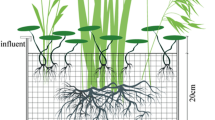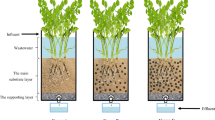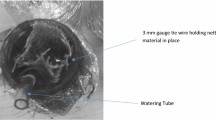Abstract
Phosphorus (P) removal efficiency of constructed wetland (CW) was limited due to the adsorption saturation on substrate surface along with continuous operation of CW. This study attempted to improve the P removal of CW through introduction of plant growth-promoting rhizobacteria (PGPR). Compared with the control-CW (C-CW), the results of CW with bio-augmentation (B-CW) showed that the total phosphorus (TP) removal efficiency was increased by 36.7% due to the enhanced plant uptake of P. The physiology indicators (height and root activity) of plants in B-CW were significantly improved, and the average P content of plants in B-CW was 0.78 g/kg, which was 85.7% higher than that of C-CW (0.42 g/kg). This was because PGPR addition optimized the P forms adsorbed on substrate surface and increased the proportion of Ca/Mg-P which was bioavailable for plant growth, and then subsequently enhanced plant uptake of P. Through bio-augmentation, the proportion of P removal by plant uptake in B-CW (25.2%) was increased by 2.5 times compared with that of C-CW (7.1%). The outcomes of this study would shed light on intensifying the role of plant uptake in P removal of CWs through bio-augmentation.






Similar content being viewed by others
Data availability
All data generated or analyzed during this study are included in this published article.
References
APHA (2017) Standards methods for the examination of water and wastewater, 23th edn. American Public Health Association, Washington, DC
Arias CA, Del BM, Brix H (2001) Phosphorus removal by sands for use as media in subsurface flow constructed reed beds. Water Res 35(5):1159–1168
Babatunde AO, Zhao YQ (2009) Forms, patterns and extractability of phosphorus retained in alum sludge used as substrate in laboratory-scale constructed wetland systems. Chem Eng J 152(1):8–13
Backer R, Rokem JS, Ilangumaran G, Lamont J, Praslickova D, Ricci E, Subramanian S, Smith DL (2018) Plant growth-promoting rhizobacteria: context, mechanisms of action, and roadmap to commercialization of biostimulants for sustainable agriculture. Front Plant Sci 9:1473
Behbahani M (2010) Investigation of biological behavior and colonization ability of Iranian indigenous phosphate solubilizing bacteria. Sci Hortic 124(3):393–399
Bielinis E, Jozwiak W, Robakowski P (2015) Modelling of the relationship between the SPAD values and photosynthetic pigments content in Quercus petraea and Prunus serotina leaves. Dendrobiology 73:125–134
Blanco I, Molle P, Saenz DM, Ansola G (2016) Basic oxygen furnace steel slag aggregates for phosphorus treatment. Evaluation of its potential use as a substrate in constructed wetlands. Water Res 89:355–365
Brisson J, Chazarenc F (2009) Maximizing pollutant removal in constructed wetlands: should we pay more attention to macrophyte species selection? Sci Total Environ 407(13):3923–3930
Carvalheira M, Oehmen A, Carvalho G, Reis MAM (2014) The effect of substrate competition on the metabolism of polyphosphate accumulating organisms (PAOs). Water Res 64:149–159
Dzakpasu M, Scholz M, McCarthy V, Jordan S (2015) Phosphorus retention and mass balance in an integrated constructed wetland treating domestic wastewater. Water Environ J 29(2):298–306
Etesami H, Maheshwari DK (2018) Use of plant growth promoting rhizobacteria (PGPRs) with multiple plant growth promoting traits in stress agriculture: action mechanisms and future prospects. Ecotox Environ Safe 156:225–246
Feng C, Wang S, Chen S (2011) Research progrss of competition and control between PAOs and GAOs for different cabon sources. Chem Ind Eng Prog 30:196–202
Forbes MG, Dickson KL, Saleh F, Waller WT, Doyle RD, Hudak P (2005) Recovery and fractionation of phosphorus retained by lightweight expanded shale and masonry sand used as media in subsurface flow treatment wetlands. Environ Sci Technol 39(12):4621–4627
Goswami D, Thakker JN, Dhandhukia PC (2016) Portraying mechanics of plant growth promoting rhizobacteria (PGPR): a review. Cogent Food Agric 2(1):1127500
Hylander LD, Siman G (2001) Plant availability of phosphorus sorbed to potential wastewater treatment materials. Biol Fertil Soils 34(1):42–48
Ji M, Hu Z, Hou C, Liu H, Ngo HH, Guo W, Lu S, Zhang J (2020) New insights for enhancing the performance of constructed wetlands at low temperatures. Bioresour Technol 301:122722
Jin XC, Wang SR, Pang Y, Wu FC (2006) Phosphorus fractions and the effect of pH on the phosphorus release of the sediments from different trophic areas in Taihu Lake, China. Environ Pollut 139(2):288–295
Jin X, Jiang X, Yao Y, Li L, Wu F (2007) Effects of organisms on the release of phosphorus at the interface between sediment and water. Water Environ Res 79(11):2253–2259
Katsaounos CZ, Giokas DL, Leonardos ID, Karayannis MI (2007) Speciation of phosphorus fractionation in river sediments by explanatory data analysis. Water Res 41(2):406–418
Khan N, Bano A (2016) Modulation of phytoremediation and plant growth by the treatment with PGPR, Ag nanoparticle and untreated municipal wastewater. Int J Phytoremediat 18(12):1258–1269
Lewis RW, Bertsch PM, McNear DH (2019) Nanotoxicity of engineered nanomaterials (ENMs) to environmentally relevant beneficial soil bacteria—a critical review. Nanotoxicology 13(3):392–428
Li X, Guo R (2017) Comparison of nitrogen removal in floating treatment wetlands constructed with Phragmites australis and Acorus calamus in a cold temperate zone. Water Air Soil Pollut 228(4):132
Li J, Fan J, Zhang J, Hu Z, Liang S (2018) Preparation and evaluation of wetland plant-based biochar for nitrogen removal enhancement in surface flow constructed wetlands. Environ Sci Pollut R 25(14):13929–13937
Lu S, Zhang X, Wang J, Pei L (2016) Impacts of different media on constructed wetlands for rural household sewage treatment. J Clean Prod 127:325–330
Lv X, Sun Y, Zhang Y (2007) Comparative research on the influences of several high efficient phosphate-solubilizing strains on phosphate solubilizing activity. Transactions of the CSAE 23(5):195–197
Mehta P, Walia A, Kakkar N, Shirkot CK (2014) Tricalcium phosphate solubilisation by new endophyte Bacillus methylotrophicus CKAM isolated from apple root endosphere and its plant growth-promoting activities. Acta Physiol Plant 36:2033–2045
Nandakumar S, Pipit H, Ray S, Haritash AK (2019) Removal of phosphorous and nitrogen from wastewater in Brachiaria-based constructed wetland. Chemosphere 233:216–222
Peng J, Wang B, Song Y, Yuan P, Liu Z (2007) Adsorption and release of phosphorus in the surface sediment of a wastewater stabilization pond. Ecol Eng 31(2):92–97
Przemieniecki SW, Kurowski TP, Kotlarz K, Krawczyk K, Damszel M, Pszczolkowska A, Kacprzak-Siuda K, Charenska A, Mastalerz J (2019) Bacteria isolated from treated wastewater for biofertilization and crop protection against Fusarium spp. Pathogens J Soil Sci Plant Nut 19(1):1–11
Qu J, Wang H, Wang K, Yu G, Ke B, Yu H, Ren H, Zheng X, Li J, Li W, Gao S, Gong H (2019) Municipal wastewater treatment in China: development history and future perspectives. Front Env Sci Eng 13(6):88
Reddy KR, Wang Y, DeBusk WF, Fisher MM, Newman S (1998) Forms of soil phosphorus in selected hydrologic units of the Florida everglades. Soil Sci Soc Am J 62(4):1134–1147
Rehman K, Imran A, Amin I, Afzal M (2018) Inoculation with bacteria in floating treatment wetlands positively modulates the phytoremediation of oil field wastewater. J Hazard Mater 349:242–251
Riva V, Riva F, Vergani L, Crotti E, Borin S, Mapelli F (2020) Microbial assisted phytodepuration for water reclamation: environmental benefits and threats. Chemosphere 241:124843
Sarawaneeyaruk S, Lorliam W, Krajangsang S, Pringsulaka O (2019) Enhancing plant growth under municipal wastewater irrigation by plant growth promoting rhizospheric Bacillus spp. J King Saud Univ Sci 31(3):384–389
Schindler DW, Carpenter SR, Chapra SC, Hecky RE, Orihel DM (2016) Reducing phosphorus to curb lake eutrophication is a success. Environ Sci Technol 50(17):8923–8929
Wang LM, Luo XZ, Zhang YM, Lian JJ, Gao YX, Zheng Z (2013) Effect of earthworm loads on organic matter and nutrient removal efficiencies in synthetic domestic wastewater, and on bacterial community structure and diversity in vermifiltration. Water Sci Technol 68(1):43–49
Wang J, Chen Y, Zhang D, Chen L, Peng S (2014) Effects of different phosphates on growth of Camellia olerifera seedling. J Cent South Univ For Technol 34(5):47–50
Wang Y, Cai Z, Sheng S, Pan F, Chen F, Fu J (2020) Comprehensive evaluation of substrate materials for contaminants removal in constructed wetlands. Sci Total Environ 701:134736
Wei G, Chen Y, Sun X, Chen Y, Luo F, Yu F (2019) Growth responses of eight wetland species to water level fluctuation with different ranges and frequencies. PLoS One 14(7):e0220231
Wu H, Zhang J, Li C, Fan J, Zou Y (2013) Mass balance study on phosphorus removal in constructed wetland microcosms treating polluted river water. Clean Soil Air Water 41(9):844–850
Wu S, Kuschk P, Brix H, Vymazal J, Dong R (2014) Development of constructed wetlands in performance intensifications for wastewater treatment: a nitrogen and organic matter targeted review. Water Res 57:40–55
Wu H, Zhang J, Ngo HH, Guo W, Hu Z, Liang S, Fan J, Liu H (2015) A review on the sustainability of constructed wetlands for wastewater treatment: design and operation. Bioresour Technol 175:594–601
Wu S, Lyu T, Zhao Y, Vymazal J, Arias CA, Brix H (2018) Rethinking intensification of constructed wetlands as a green eco-technology for wastewater treatment. Environ Sci Technol 52(4):1693–1694
Xu D, Wang L, Li H, Li Y, Howard A, Guan Y, Li J, Xu H (2015) The forms and bioavailability of phosphorus in integrated vertical flow constructed wetland with earthworms and different substrates. Chemosphere 134:492–498
Yang Y, Zhao Y, Liu R, Morgan D (2018) Global development of various emerged substrates utilized in constructed wetlands. Bioresour Technol 261:441–452
Yin H, Yan X, Gu X (2017) Evaluation of thermally-modified calcium-rich attapulgite as a low-cost substrate for rapid phosphorus removal in constructed wetlands. Water Res 115:329–338
Zhang J, Sun H, Wang W, Hu Z, Yin X, Ngo HH, Guo W, Fan J (2017) Enhancement of surface flow constructed wetlands performance at low temperature through seasonal plant collocation. Bioresour Technol 224:222–228
Zhao X, Yang J, Bai S, Ma F, Wang L (2016) Microbial population dynamics in response to bioaugmentation in a constructed wetland system under 10°C. Bioresour Technol 205:166–173
Zhao B, Qi K, Yi X, Chen G, Liu X, Qi X, Zhang S (2019) Identification of hexokinase family members in pear (Pyrus x bretschneideri) and functional exploration of PbHXK1 in modulating sugar content and plant growth. Gene 711:143932
Funding
This work was supported by the Shandong Provincial Key Research and Development Program (Major Scientific and Technological Innovation Project) (No. 2019JZZY010411 & No. 2020CXGC011406), National Science Foundation of China (No. 51878388 & No. 51925803), Natural Science Foundation of Shandong Province (No. ZR2020YQ42), and Future Plan for Young Scholar of Shandong University.
Author information
Authors and Affiliations
Contributions
Mingde Ji designed research, performed research, analyzed data, and wrote the manuscript; Jian Zhang contributed in data collection and visualization; Shuo Wang helped in checking the visualized results and revising the manuscript; Shuang Liang contributed in proofreading and giving valuable comments. This study was done under the supervision of Zhen Hu.
Corresponding author
Ethics declarations
Ethical approval
All the authors have checked and agreed to submit this manuscript into Environmental Science and Pollution Research.
Consent to participate
This paper used the secondary data collected from the Web of Science; in this study, there is no involvement of human nor any animal.
Consent to publish
Authors are well aware and sure that the used data in this manuscript is not previously published.
Competing interests
The authors declare no competing interests.
Additional information
Responsible Editor: Alexandros Stefanakis
Publisher’s note
Springer Nature remains neutral with regard to jurisdictional claims in published maps and institutional affiliations.
Supplementary Information
ESM 1
(DOCX 52 kb)
Rights and permissions
About this article
Cite this article
Ji, M., Zhang, J., Wang, S. et al. Enhanced phosphorus removal of constructed wetland through plant growth-promoting rhizobacteria (PGPR) addition. Environ Sci Pollut Res 28, 52124–52132 (2021). https://doi.org/10.1007/s11356-021-14364-w
Received:
Accepted:
Published:
Issue Date:
DOI: https://doi.org/10.1007/s11356-021-14364-w




